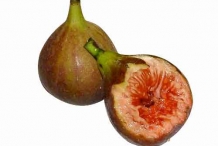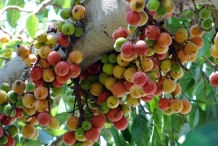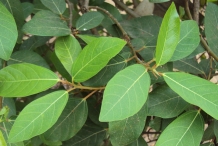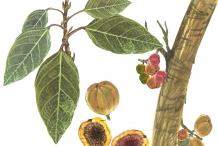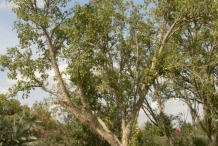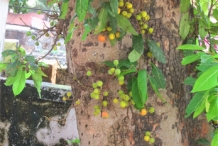| Cluster Figs Quick Facts |
| Name: |
Cluster Figs |
| Scientific Name: |
Ficus racemosa |
| Origin |
Native to Indian Subcontinent, Southern China, Southeast Asia, Papua New Guinea to Northern Australia Northern Territory, North of Western Australia and Queensland. It is also introduced to other tropical regions in the South America. |
| Colors |
Dull reddish-dark crimson (Fruit) |
| Shapes |
Subglobose, pyriform; Diameter: 2.5-5 cm (Fruit) |
| Major nutrients |
Vitamin B2 (30.77%)
Iron (16.25%)
Copper (11.11%)
Potassium (10.81%)
Magnesium (8.33%)
|
| Health benefits |
Production of RBC, Prevent anemia, Mental performance, Sleeping disorders, Produces energy |
| More facts about Cluster Figs |
Cluster Figs (Ficus racemosa), also called Cluster Fig, Cluster Tree, Cluster Fig Tree, Goolar Fig, Country Fig and Redwood Fig, is a medium sized tree native to Indian Subcontinent, Southern China, Southeast Asia, Papua New Guinea to Northern Australia Northern Territory, North of Western Australia and Queensland. It is also introduced to other tropical regions in the South America. Udumbara, Nayodumbara and Phalgu are the three varieties of Cluster figs. The tree bears a subglobose and pyriform fruit of about 2.5-5 cm diameter. The bark has the thickness about 8-10 mm.
Plant
Cluster fig is an erect, laticiferous, deciduous and evergreen tree which grows upto 25-30 m in height with a trunk diameter as 60-90 cm. It has long, irregular and brownish roots. The bark is smooth, greyish to brownish which has 8-10 mm as a thickness. Leaves are alternate, elliptic to obovate in a pale green of size 10-14 × 3-7 cm. Fruits are subglobose and pyriform shaped which has 2.5-5 cm as a diameter in dull reddish to dark crimson. Each fruit has lenticular seeds of 1 mm long.
Nutritional value
The serving size of 100 grams covers 81.9 grams of water, 1.3 grams of protein, 0.6 grams of total fat, 0.6 grams of ash, 0.21 grams of nitrogen and no carbohydrate. It covers 30.77% of Vitamin B2, 16.25% of Iron, 11.11% of Copper, 10.81% of Potassium, 8.335 of Magnesium, 7.20% of Calcium and 6.71% of Phosphorus.
Health Benefits of Cluster fig
Cluster fig is loaded with various medicinal properties which is beneficial for the health. It consists of phytochemicals which helps to prevent and aid the diseases. It is used to treat muscular pain, pimples, boils, cuts, hemorrhoids etc. It is anti-diabetic, antioxidant, anti-asthmatic, antiulcer, anti-diarrheal and anti-pyretic action. The juice extracted from the fruit is used to treat hiccups.
- Production of RBC
Vitamin B2 is required to produce fresh red blood cells as well as antibodies in the body which helps to increase the oxygenation and circulation to the various organs of the body. (1)
- Prevent anemia
Iron helps to cure anemia which is experienced by the women during menstruation or pregnancy. The lost red blood cells should be replaced with new red blood cells for which one should consume adequate amount of iron which is essential for the women in that points. Anemia is caused due to the deficiency of iron in the human body. About millions of people in the world are suffering from anemia. It has become a common problem. (2)
- Mental performance
The adequate amount of iron helps the one to provide energy and focus concentration which helps to enhance the mental and cognitive performance. It helps to increase the blood flow to the brain due to the activity of iron’s red blood cell. (3)
- Sleeping disorders
Iron helps to treat insomnia and enhance the sleeping quality and habits by regulating the circadian rhythms. Due to the proper count of red blood cells, it leads to the fluctuation in blood pressure which could be a cause for awakening at night. (4)
- Produces energy
Copper is required for the adenosine triphosphate synthesis which is a storehouse of energy in the human body. The intracellular production of energy is affected by the cytochrome c oxidase and cuproenzyme. It performs as a catalyst which helps to reduce the molecular oxygen to water, during those enzymes produce the electrical gradient which is used by mitochondria in order to synthesize the important energy storing molecule called ATP. The adequate amount of copper in the body assists in the proper functions and energy without having the feel of tired or lethargic. (5)
- Enhance immunity
Copper is essential for the healing process and promotes healing of wounds. It builds the immunity and acts as an aid for anemia, which permits the body to heal and defend faster. It is essential for the enzymatic processes that helps in the endothelial growth or the tissue healing process. (6)
- Prevent stroke
Potassium plays a vital role in maintaining the brain functions. The high amount of potassium allows the body to transport the oxygen to the brain by enhancing the neural activities and raising the cognitive functions. It helps to prevent the stroke in the brain. It performs as a vasodilator that relaxes the blood vessels. It assists in the free flow of blood and prevents the chances of break off and clot that causes strokes. (7)
- Muscle problems
It assists in the regular contraction of muscles. The adequate levels of potassium are essential for the relaxation and contraction of muscles. The potassium ions are located in the muscle cells in the human body. It maintains the nerve and muscle function and reflexes fast as it promotes the neural connectivity of brain and muscles. (8)
- Heart ailments
Magnesium prevents the irregular heartbeats and reduces the damage of heart due to muscle stress. It soothes the nerves, digestive processes which help to prevent the problems such as cramps, vomiting, abdominal pain, indigestion, flatulence and constipation. The deficiency of magnesium could result to the harmful results. (9)
- Prevent cramps
Magnesium helps to relax the kidney stress, back muscles and muscular tension. It assists in the calcium absorption which helps to heal the bones faster. The deficiency of magnesium shows the symptoms of leg cramps and general fatigue. The adequate intake of magnesium helps to aid the chronic leg cramp ailments. (10)
Traditional uses
- The decoction made with the mixture of 250 gm, 1 gm phitkari and 3 gm catechu is used to gargle that effectively treats any sort of mouth problems.
- The gum paste is applied to treat the swelling of ears, muscles caused due to inflammations.
- The eruptions on leaves should be grinded with 3-4 gm of milk which is strained and mixed with honey. The patient should be given this mixture twice a day which helps to prevent the pus in the boils and treats.
- The eruptions should be grinded with honey and sugar which should be provided once a day. This helps to cure Multinodular tuberculosis.
- With the help of cotton, place its milk on the sinus. The cotton should be changed regularly. This remedy helps to treat sinus in a few days.
- The intake of fruits helps to treat stomach pain.
- About 5 to 10 ml of juice should be provided to the Leucorrhoea patient twice in a day along with sugar candy.
- The milk which is infused with fruits of Cluster fig should be consumed with meals. This prevents abortion and stimulates the fetus growth.
- 10-15 ml of grinded bark of Cluster fig should be cooked in 250 ml of water. It should be cooked till the water becomes half. The strained solution should be added 1.5 gm of white cumin seed powder and sugar candy. It should be given twice a day. This helps to treat Metrorrhagia.
- Honey should be added to the grinded leaves of Cluster fig. This paste helps to cure Pitta.
- The patients of bronchial asthma and bronchitis should consume the fruits by making a squash. It is helpful for them.
- The dried peel of Cluster fig’s fruits should be grinded and sugar candy should be mixed with it. The people with urinary disorders should be given 6-6 gm of this powder along with the cow’s milk twice in a day.
- In India, this plant is used to cure diarrohea, dysentery, stomachache, diabetes and piles and used as carminative, anticancer and antioxidant agent.
- Fruits are considered as astringent, carminative and stomachic which provide relief from diarrhea, dysentery and treat diabetes.
- The paste made from the fruit paste is an aid for visceral obstruction, constipation and regulates diarrhea.
- Seed paste is used to cure measles, smallpox and diarrhea.
- The mixture of powdered leaves powdered and honey used to cure bilious infections, diarrhea, and dysentery and used as a mouth wash.
- Cow milk and leaf latex are mixed which is useful for boils, measles and blisters.
- The juice of leaf juice is used to massage hair.
- The infusion made from leaves is used to treat menorrhoea.
- The traditional healers use the milky sap as anti-inflammatory agent for mumps and inflammation.
- The milky sap is used to treat diarrhea, stomach ache, piles, dysentery and cholera.
- Bark has astringent properties which are used internally to treat menorrhagia, dysentery and haemoptysis.
- The decoction made from bark is used to treat various skin ailments, diabetes and ulcers.
- It is used as a poultice in inflammatory boils/ swellings, burns.
- The powdered stem bark is used to enhance the milk secretion for the lactating mothers.
- In Sri Lanka, the paste made from stem bark is used to cure the skeletal fracture.
- In Thailand, the root is used to cure dysentery and pyresis.
- The sap of root sap is used as an aid for chronic wounds, heat stroke and malaria.
- It is used in Ayurved to treat fractured bones, heavy periods and diabetes.
- The topical application of latex is applied on boils, cuts, muscular pains, scabies, pimples and hemorrhoids.
- The paste of tender leaf buds is applied to the skin to enhance the complexion.
- The plant is considered to be anti-diabetic, astringent, anti-asthmatic, antioxidant, anti-inflammatory, antiulcer, anti-diarrheal and anti-pyretic properties.
- The unripe fruit bark and leaves provides relief from flatulence, stimulates appetite, assist digestion and eliminates parasitic worms.
- The bark of Cluster fig is grinded on a stone with water which is applied to the swollen areas.
- In India, the paste is made from the bark rubbed on stone with which helps to cure the boils and mosquito bites.
- It helps to cure asthma, bronchitis, laryngitis, spleen and kidney diseases.
- The tree milk helps to eliminate the pain caused due to hand and feet blisters.
- In bleeding gums and mouth ulcers, the gurgles with the extract of the bark are very helpful.
- The figs are added to the side dishes and preserves as a vegetable.
- The stem bark was used as an ingredient in the nutra tea to have a beneficial effect.
- The paste made with the inner side of the bark is applied to the freckles and pimples. It helps to reduce them effectively.
- The application of the paste made with the Cluster fig and honey helps to maintain the skin tone.
- The intake of 10-15 ml of juice extracted from Cluster fig helps to cure dysentery.
- Stomach aches could be treated if the Cluster fig is consumed with ajwain and rock salt.
- The latex should be applied on the heels to have smooth and supple feet.
- Cook 400 ml of water with 10 gm of Cluster fig bark. Then add a pinch of alum and strain. Rinse the mouth with this solution to get rid from oral infections.
- About 7-14 ml of leaves juice of Cluster fig should be consumed twice in a day. It helps to treat Dhatu Kshaya.
- The topical application of root’s latex helps to provide relief from cuts and muscle pain.
How to eat
- An unripe fruits are added to culinary purposes such as pickles, sambar, chutney, curry and Sabji.
- The unripe fruits are preserved in salt.
- The bark is used to make Kashayam.
- Ripe fruits are consumed fresh or preserved in the honey for the future use.
- The fresh figs are added to cakes, salads and ice-creams.
- The dried figs are added to stews, soup and lamb meat.
- Dried figs are added to breakfast cereal, cakes, muffins, pies, sandwiches and cheesecakes.
Precautions
- Those who are allergic to Cluster figs should not use it.
- The ripe fruit should be avoided in the culinary uses as it may worsen the condition of intestinal worm infestation.
- One should consult the doctor for using Cluster figs during pregnancy.
References:
http://easyayurveda.com/2014/12/16/udumbar-ficus-racemosa-uses-research-side-effects/
http://www.bimbima.com/health/post/2014/11/19/cluster-figgular-health-benefits.aspx
http://www.fruitsinfo.com/cluster-fig-fruit.php
http://www.theayurveda.org/ayurveda/herbs/12-health-benefits-medicinal-plant-cluster-fig-plant/
https://en.wikipedia.org/wiki/Ficus_racemosa
https://sites.google.com/site/medicinalplantshealing/list-of-plants/cluster-fig
https://sites.google.com/site/efloraofindia/species/m—z/m/moraceae/ficus/ficus-racemosa
http://naturehealthathome.blogspot.com/2015/03/the-health-benefits-of-guler-figs.html
Comments
comments



